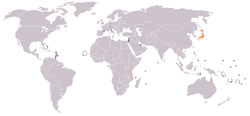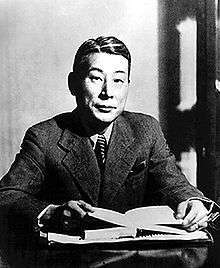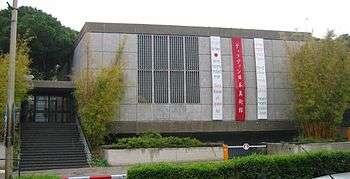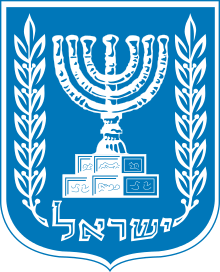Israel–Japan relations
 |
|
Israel |
Japan |
|---|---|
Israeli–Japanese relations began on May 15, 1952 when Japan recognized Israel and an Israeli legation opened in Tokyo. In 1954 Japan's ambassador to Turkey assumed the additional role of minister to Israel. In 1955 a Japanese legation with a Minister Plenipotentiary opened in Tel Aviv. In 1963, relations were upgraded to Embassy level, and have remained on that level since then.[1] Japan's trade relations with Arab nations and Iran take precedence over those with Israel.[2] However, due to the declining price of oil in early 2015, as well as internal political shifting in Japan, the two nations are seeking increased research, economic and cultural ties, particularly in the area of tech start-ups and defense.[3]
1920s
In 1922, Norihiro Yasue and Koreshige Inuzuka, head of the Japanese Imperial Navy's Advisory Bureau on Jewish Affairs, returned from their military service in Siberia to provide aid to the White Russians against the Red Army. They became particularly interested in Jewish affairs after having learned of the Protocols of the Elders of Zion. Over the course of the 1920s, they wrote many reports on the Jews, and traveled to the British Mandate of Palestine to research them and to speak with Zionist leaders Chaim Weizmann and David Ben-Gurion. Yasue even translated the Protocols into Japanese (variations of it have frequently made the bestseller lists in Japan). The pair managed to get the Foreign Ministry of Japan, or Gaimusho, interested in Judaism. Every Japanese embassy and consulate was requested to keep the Ministry informed of the actions and movements of Jewish communities in their respective countries.
Fugu Plan
The Fugu Plan was an idea first discussed in 1934, in Imperial Japan, centered around the idea of settling thousands, if not tens of thousands, of Jewish refugees escaping Nazi-occupied Europe, in Manchuria and Japanese-occupied Shanghai. The Imperial government wanted to gain Jewish economic prowess while convincing the United States, specifically American Jewry, to grant their favor and invest in Japan. The Plan was first discussed in 1934, and solidified in 1938 at the Five Ministers' Conference, but the signing of the Tripartite Pact in 1940, along with a number of other events, prevented its full implementation.
The plan was originally the idea of a small group of Japanese government and military officials led by Captain Koreshige Inuzuka and Colonel Norihiro Yasue who came to be known as the "Jewish experts", along with industrialist Yoshisuke Aikawa and a number of officials in the Kwantung Army known as the "Manchurian Faction". The plan was named after the Japanese delicacy "fugu", a puffer-fish whose poison can kill if the dish is not prepared exactly correct. The plan was based on a naive acceptance of European anti-Semitic prejudices, as found in the Japanese acceptance of The Protocols of the Elders of Zion as fact. Their misconception of Jewish power and wealth was partly due to their experience with Jacob Schiff, a Jewish-American banker who, thirty years earlier, loaned money to the Japanese government that allowed it to win the Russo-Japanese War.
The "Jewish experts" joined forces, to an extent, with the "Manchurian Faction", Japanese military officials who wished to push for Japanese expansion into Manchuria. The faction was headed by Colonel Seishirō Itagaki and Lieutenant-Colonel Kanji Ishiwara, who were having trouble attracting Japanese settlers or investment into Manchuria. In 1938, top government officials discussed the ideas and plans of the "Jewish experts" in the Five Ministers' Conference. The Plan never got off the ground. In 1939, the Jews of Shanghai requested that no more Jewish refugees be sent into Shanghai, as their community's ability to support them was being stretched thin.
During World War II

In 1939, the Soviet Union signed a non-aggression pact with Nazi Germany, making the transport of Jews from Europe to Japan far more difficult. The Japanese government signed the Tripartite Pact with Germany and Italy, completely eliminating the possibility of any official aid for the Plan from Tokyo.
However, Chiune Sugihara, the Japanese Consul in Kovno, Lithuania, began to issue, against orders from Tokyo, transit visas to escaping Jews, allowing them to travel to Japan and stay there for a limited time, ostensibly stopping off on their way to their final destination, the Dutch colony of Curaçao, which required no entry visa. Thousands of Jews received transit visas from him, or through similar means. Some even copied, by hand, the visa that Sugihara had written. After the grueling process of requesting exit visas from the Soviet government, many Jews were allowed to cross Russia on the Trans-Siberian Railway, then took a boat from Vladivostok to Tsuruga, and eventually settled in Kobe, Japan.
Settler plans
Plans allowed for the settler populations to range in size from 18,000 up to 600,000 depending on how much funding and how many settlers were supplied by the world Jewish community. It was agreed, by all the planners, that Jewish settlers would be given complete freedom of religion, along with cultural and educational autonomy. While the Japanese were wary of giving the Jews too much freedom, they felt that some freedom would be necessary to maintain their favor, and their economic proficiencies. The officials asked to approve the plan insisted that, while the settlement was to appear autonomous, controls needed to be placed, behind the scenes, to keep Jews under close watch and under control. They feared that the Jews might take over mainstream Japanese government and economy, taking command of it the way they, according to The Protocols of the Elders of Zion, "had done in many other countries."
Impact
Several thousand Jews were rescued from almost certain death in Nazi-Occupied Europe by the policies surrounding Japan's temporary pro-Jewish attitude, and Chiune Sugihara was bestowed the honor of the Righteous Among the Nations by the Israeli government in 1985. In addition, the Mir Yeshiva, one of the largest centers of rabbinical study today, and the only yeshiva to survive the Holocaust, survived as a result of these events.
Post-1950s relations

In 1993 both nations signed the "Convention between Japan and the State of Israel for the Avoidance of Double Taxation and the Prevention of Fiscal Evasion with Respect to Taxes on Income."[1] In 2000, the two nations signed the "Agreement between the Government of Japan and the Government of the State of Israel for Air Services."[1] There were 708 Japanese nationals in Israel as of October 1999 and 604 Israeli nationals in Japan as of December 1998.[1]
The Japanese government appointed Yoshinori Katori, press secretary at the Foreign Ministry, as ambassador to Israel on August 1, 2006. Katori previously served as minister to South Korea and director-general of the Consular Affairs Bureau before assuming the current post in August 2005.[5] In September 2008, Katori ended his post to Israel and was replaced by ambassador Haruhisa Takeuchi, who presented his credentials on December 1, 2008.
In July 2006, Japan announced a plan for peace called "Corridor for Peace and Prosperity", which would be based on common economic development and effort by Israelis and Palestinians, rather than on continuous contention over land.[6] Shimon Peres gave this idea much attention during his participation in an international conference in New York in September 2006 which was organized by former U.S. President Bill Clinton.[7]
In July 2008, the Japanese government reiterated its support for the plan in meetings with Israelis and Palestinians, and urged the sides to continue working towards completion. Japan also indicated specific support for an agro-industrial park to be built near Jericho, and said it hopes to begin construction by 2009.[8][9]
Economy
Until the 1990s, Japan was the industrialized nation that acquiesced most strongly to the Arab demands to boycott Israel. As a result, economic relations have been limited for most of the State of Israel's history.[10]
Israeli exports to Japan, consisting primarily of polished diamonds, chemical products, machinery, electrical equipment, and citrus fruit are worth $810 million. Japanese exports to Israel, consisting primarily of automobiles, machinery, electrical equipment, and chemical products, are worth $1.3 billion.[1]
Academic relations
Universities in both countries are making special efforts to conduct lively exchange of studies. On May 2012, a symposium to commemorate the sixtieth anniversary of the diplomatic relations was held at the Hebrew University, to discuss issues of regional, bilateral, and cultural exchanges. The Israeli Association of Japanese studies was also launched on that occasion.
Visits
| Year | To Israel | To Japan |
|---|---|---|
| 1985 | Foreign Minister Yitzhak Shamir | |
| 1988 | Foreign Minister Sousuke Uno | |
| 1989 | President Chaim Herzog, Foreign Minister Moshe Arens | |
| 1990 | President Chaim Herzog | |
| 1991 | Foreign Minister Taro Nakayama | |
| 1992 | Foreign Minister Shimon Peres | |
| 1994 | Foreign Minister Koji Kakizawa, Special Envoy Kabun Muto | Prime Minister Yitzhak Rabin |
| 1995 | Prime Minister Tomiichi Murayama, Foreign Minister and Special Envoy Yohei Kono | |
| 1996 | Foreign Minister Yukihiko Ikeda | |
| 1997 | Foreign Minister David Levy, Prime Minister Benjamin Netanyahu | |
| 1999 | Foreign Minister Masahiko Koumura, State Secretary for Foreign Affairs Nobutaka Machimura, Senior State Secretary for Foreign Affairs Shozo Azuma | Deputy Minister of Foreign Affairs Nawaf Massalha |
| 2002 | Foreign Minister Yoriko Kawaguchi | |
| 2003 | Foreign Minister Yoriko Kawaguchi | |
| 2005 | Foreign Minister Nobutaka Machimura | |
| 2006 | Prime Minister Junichiro Koizumi | |
| 2008 | Prime Minister Ehud Olmert | |
| 2014 | Prime Minister Benjamin Netanyahu | |
| 2015 | Prime Minister Shinzo Abe |
Quotes
- "Israel and Japan are situated at opposite ends of Asia, but this is a fact which binds them together rather than separates them. The vast continent of Asia is their connecting link, and the consciousness of their Asian destiny is their common thought." – Israeli Prime Minister David Ben-Gurion, July 1, 1952[11]
- Both Israel and Japan are "ancient peoples who have risen from the ashes of the Second World War to build on the platform of our ancient cultures thriving, successful and advanced societies." – Israeli Foreign Minister Silvan Shalom, January 17, 2005[12]
See also
- Antisemitism in Japan
- History of the Jews in Japan
- International recognition of Israel
- Japanese-Jewish common ancestry theory
- Makuya
References
- 1 2 3 4 5 Japan-Israel Relations Ministry of Foreign Affairs of Japan
- ↑ Relations with Asian States Library of Congress Country Studies
- ↑ Lipshiz, Cnaan (6 January 2015). "After decades of distance, Japan seeks closer ties with Israel". Start-Up Israel. The Times of Israel. Retrieved 11 January 2015.
- ↑ Sakamoto, Pamela Rotner (1998). Japanese diplomats and Jewish refugees: a World War II dilemma. New York: Praeger. ISBN 0-275-96199-0.
- ↑ Katori named Japan ambassador to Israel KERALANEXT.com
- ↑ Japan's Concept for Creating the Corridor for Peace and Prosperity (Background Paper) July, 2006, Government of Japan.
- ↑ Peres to meet Musharraf and kings of Jordan, Morocco, Israel Today, 9/18/06.
- ↑ Japanese still solid on PA industry project ASSOCIATED PRESS, Jul 3, 2008, at jpost.com.
- ↑ Press statement: The Third Ministerial-Level Meeting of the Four-Party Consultative Unit for the "Corridor for Peace and Prosperity" Japan Min of Foreign Affairs, 2 July 2008, Tokyo. In 2011 Japanese Earthquake, Israel was among first to respond with humanitarian aid.
- ↑ Feiler, Gil. "Arab Boycott." The Continuum Political Encyclopedia of the Middle East. Ed. Avraham Sela. New York: Continuum, 2002. pp. 54-57
- ↑ Before Oil: Japan and the Question of Israel/Palestine, 1917-1956 Z Magazine
- ↑ Politics/Gov´t Friendly Relations With Japan Arutz Sheva
![]() This article incorporates public domain material from the Library of Congress Country Studies website http://lcweb2.loc.gov/frd/cs/.
This article incorporates public domain material from the Library of Congress Country Studies website http://lcweb2.loc.gov/frd/cs/.
Further reading
- Rabbi Marvin Tokayer, The Fugu Plan. New York: Weatherhill, Inc. (1979)
- John Katz, Israeli–Japanese Relations, 1948–1963 Tel Aviv: Saar (2007)
External links
- Security Incidents Set Tone for Japanese PM's Visit Ynetnews
- "Investigators launch probe into Japan boat crash" (Haaretz)
- "Friendly Relations With Japan"
- "EVS Receives Award from Israel-Japan Chamber of Commerce"
- "Japanese Policy in the Middle East", Raquel Shaoul
- Badr Abdel-Aati, "The Influence of External Factors on Foreign Policy: A Case Study of Japanese Policies towards Israel -1973-2003-"
- "ADL Leaders, in Tokyo, Praise Japan's Leadership in Global War Against Terrorism"
- "Japan's Koizumi mulling visits to Israel, Palestinian territories"
- "Japan and the Middle East: Signs of Change?"
- Japan-Israel Fellowship

